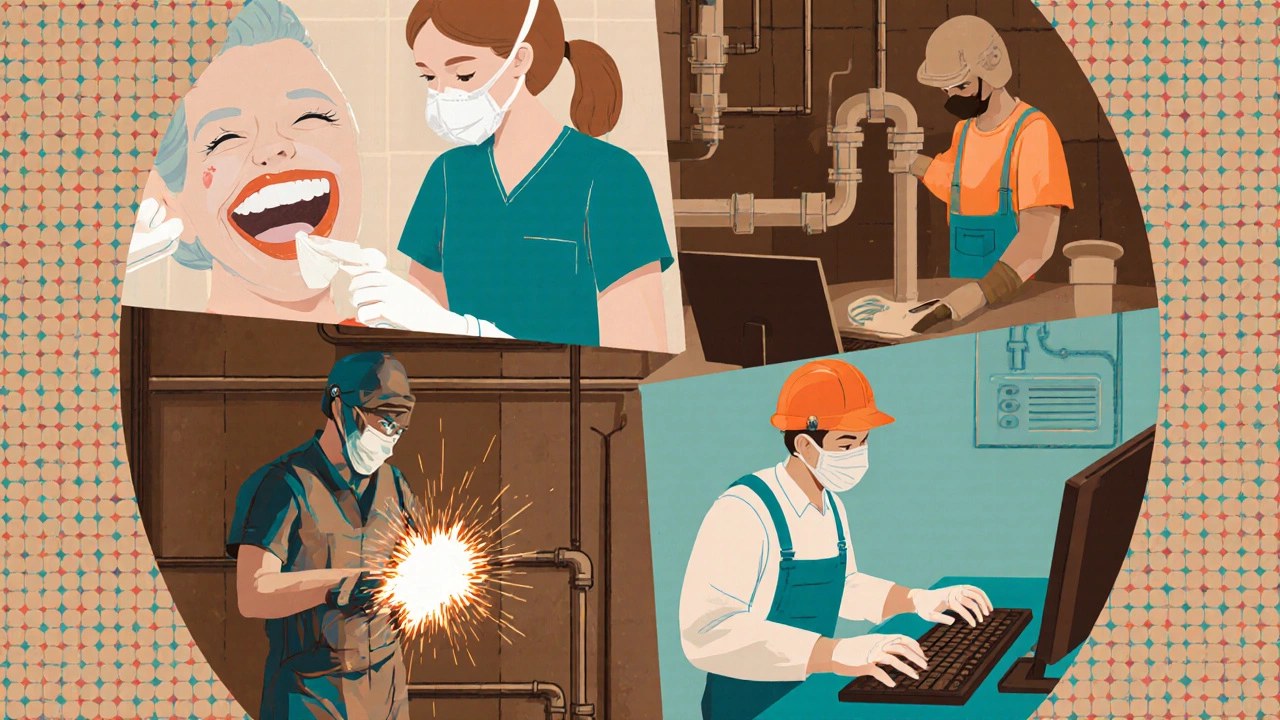Vocational Career Salary Calculator
Compare Your Future Earnings
Understand how vocational training compares to university degrees in real-world earnings, debt, and time to financial independence.
A vocational job isn’t just another job. It’s a career built on doing, not just thinking. You don’t need a four-year degree to become a welder, electrician, plumber, or dental hygienist-but you do need real, hands-on training. These roles don’t sit behind desks. They’re in garages, hospitals, construction sites, and kitchens. And they pay well, often better than many white-collar jobs that require the same amount of time in school.
It’s About Skills, Not Degrees
What makes a job vocational isn’t the title. It’s the way you learn it. Vocational jobs require training that’s focused on specific, practical skills. You learn by doing. You fix things. You install systems. You care for patients. You operate machinery. The end goal isn’t to write essays or pass multiple-choice exams-it’s to prove you can perform a task safely and correctly.
Think about a certified nursing assistant. They don’t need a bachelor’s in biology. They need 75 hours of classroom instruction and 16 hours of clinical practice. After that, they take a state exam. If they pass, they can start working in a nursing home. That’s it. No student loans, no thesis, no internships that don’t pay. Just direct, targeted training that leads straight to a job.
This is different from academic education. In college, you might study the history of medicine. In vocational training, you learn how to take a patient’s blood pressure, change a dressing, and help someone walk after surgery. One builds knowledge. The other builds ability.
Real Jobs, Real Demand
There’s a myth that vocational jobs are dead-end. That’s not true. In Canada, over 40% of new job openings between now and 2030 will be in skilled trades and technical roles, according to the Government of Canada’s Labour Market Outlook. Many of these roles are already facing shortages.
Electricians? Shortage. Plumbers? Shortage. Heavy-duty equipment mechanics? Shortage. Even dental assistants and medical lab technicians are in demand. These aren’t jobs you can outsource. They can’t be automated easily. You need a person with trained hands and eyes.
And the pay? A licensed electrician in Ontario can earn between $60,000 and $90,000 a year after apprenticeship. A skilled welder in Alberta can make over $80,000 with overtime. Compare that to the average starting salary for a university graduate in Canada, which hovers around $50,000. Vocational paths don’t just get you to work faster-they often pay more, sooner.
Training That Fits Real Life
Vocational courses aren’t stuck in classrooms. Most are offered through community colleges, trade schools, and apprenticeship programs. You can start at 16, 25, or 45. Many programs let you work while you learn. That’s the key difference: you earn while you train.
Take the apprenticeship model. A young person signs up to become a carpenter. They spend four days a week working under a licensed contractor. One day a week, they’re in class learning building codes, safety standards, and blueprint reading. After four years, they write a certification exam. When they pass, they’re a journeyperson-and eligible for full wages.
There’s no debt trap. No $30,000 tuition bill. No waiting five years to start earning. You’re paid from day one, even if it’s minimum wage at first. As your skills grow, so does your paycheck. By year three, many apprentices are making $30 an hour. That’s $60,000 a year before taxes.

Not Just Manual Labor
Vocational doesn’t mean dirty hands. It means specialized skills. Think about a medical coder. They don’t touch patients. They sit at a computer and translate doctor’s notes into standardized codes for billing. But they need a 12-month certificate program, not a degree. Or a cybersecurity analyst trained through a 6-month bootcamp. Or a solar panel installer who learns how to wire systems on rooftops.
These are all vocational careers. They require certification, not a diploma. They demand precision, not theory. And they’re growing fast. The demand for medical coders in Canada has increased by 22% in the last three years. Solar installer jobs are expected to grow by 50% by 2028.
Vocational training covers everything from hairdressing to robotics maintenance. From pastry arts to HVAC repair. From veterinary assistants to 3D printing technicians. The field is wider than most people think.
Why People Choose Vocational Paths
People choose these jobs for clear reasons:
- Speed: You can start working in months, not years.
- Cost: Most programs cost under $10,000-many under $3,000.
- Guaranteed work: Employers hire before you even finish training.
- Flexibility: You can start at any age, even after a career change.
- Job security: These roles can’t be replaced by AI or shipped overseas.
One woman in Toronto, 42, left her office job after her company downsized. She enrolled in a 14-week medical office assistant program. She got hired two weeks before graduation. Now she earns $52,000 a year with benefits. No student debt. No regrets.

What Doesn’t Make a Job Vocational
Not every job that requires training is vocational. A marketing manager who takes a Google Ads course isn’t in a vocational role. A lawyer who goes to law school isn’t vocational. Why? Because their job isn’t defined by hands-on technical skill. It’s defined by analysis, strategy, and communication.
Vocational jobs have one thing in common: a clear, measurable output. You fix the pipe. You install the circuit. You draw the X-ray. You clean the teeth. You can see the result. You can be tested on it. There’s a standard you must meet.
If your job requires a license or certification from a provincial or national body-and you learned it through a short, skills-based program-you’re in a vocational career.
Where to Start
If you’re thinking about a vocational path, here’s how to begin:
- Look at local job postings. What skilled roles are always hiring? Check government labour market reports.
- Visit your nearest community college or trade school. Ask about entry-level programs.
- Shadow someone in the field. Talk to a plumber, an electrician, a dental assistant. Ask how they got started.
- Check for government grants. In Ontario, the Skills Development Fund helps cover tuition for in-demand trades.
- Apply for an apprenticeship. Many employers post openings on provincial job boards.
You don’t need to be good at math or science to succeed. You need patience, attention to detail, and the willingness to learn by doing.
Final Thought: A Different Kind of Success
Society still tells us that success means a university degree. But that’s changing. More young people are choosing vocational paths because they see the reality: you can build a solid, respected, well-paid career without going into debt for a degree that doesn’t guarantee a job.
Vocational jobs aren’t second choice. They’re smart choice. They’re honest work. They’re the backbone of every community. And they’re growing faster than ever.
Is a vocational job the same as a blue-collar job?
Most vocational jobs are blue-collar, but not all blue-collar jobs are vocational. Blue-collar refers to manual labor, often in manufacturing or construction. Vocational jobs are defined by formal training and certification. So while a warehouse worker might be blue-collar, they’re not necessarily vocational unless they’ve completed a certified program like forklift operation or inventory management. Vocational roles have clear standards and credentials.
Can you move up in a vocational career?
Absolutely. Many vocational careers have clear advancement paths. A junior electrician becomes a journeyperson, then a supervisor, then a contractor. A dental assistant can become a dental hygienist with additional training. A chef can open their own restaurant. The ladder exists-it’s just not always academic. Advancement comes from experience, certifications, and leadership skills, not degrees.
Do vocational jobs offer benefits?
Yes, especially in unionized trades and public sector roles. Electricians, plumbers, and healthcare support workers often get health insurance, pensions, paid vacation, and sick leave. Even in private shops, many employers offer benefits to attract and keep skilled workers. The myth that vocational jobs don’t offer benefits is outdated.
Are vocational courses only for young people?
No. Many people switch careers in their 30s, 40s, or even 50s. Community colleges and trade schools welcome adult learners. Programs are often designed with part-time, evening, or online options. In Toronto, over 30% of students in skilled trades programs are over 30. It’s never too late to learn a skill that pays.
How long does vocational training usually take?
It varies. Some programs last 6 weeks, like a certified pharmacy assistant course. Others take 1-2 years, like automotive technology. Apprenticeships usually run 3-5 years, but you’re earning the whole time. Most vocational certifications can be completed in under 12 months. That’s faster than most university degrees-and far cheaper.
Do employers prefer vocational training over degrees?
For skilled trades and technical roles, yes. Employers care more about your certification and ability to do the job than your GPA. A welder with a Red Seal certification is more valuable than a graduate with a business degree who’s never held a welding torch. In these fields, proof of skill beats paper credentials every time.
